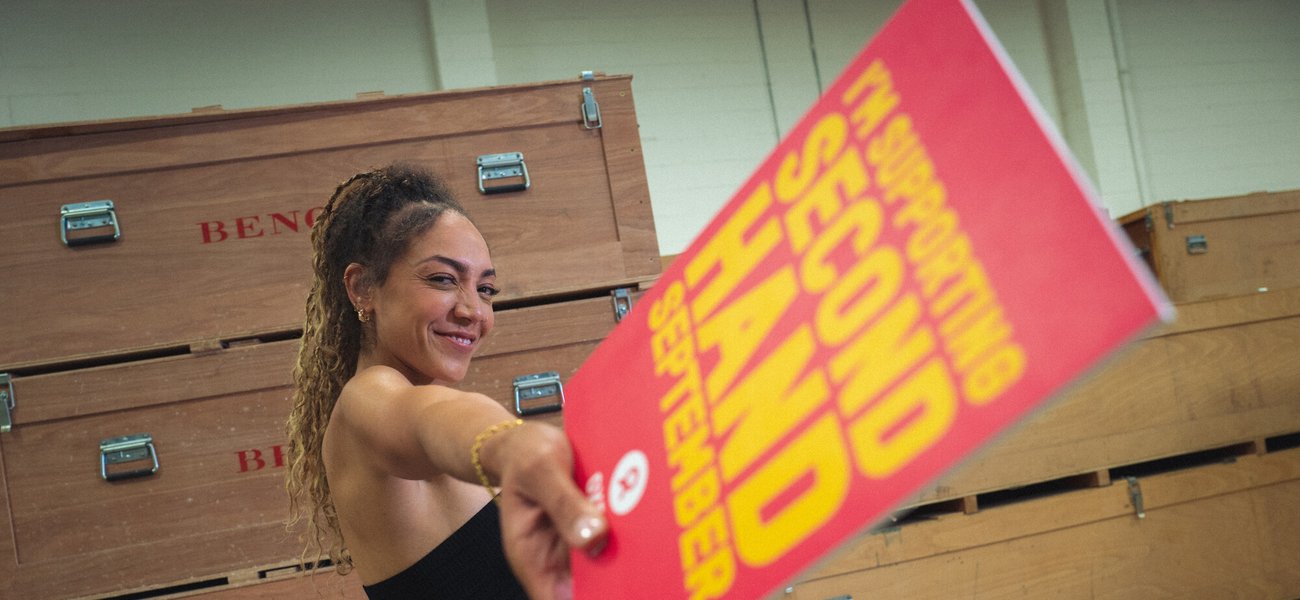
If all UK adults bought half of their next wardrobe second-hand, it could prevent a whopping 12.5 billion kilogrammes of carbon dioxide emissions entering the atmosphere, new Oxfam research reveals today. This is the equivalent to a plane flying around the world more than 17,000 times, or 261,000 flights from London (Heathrow) to Greece (Athens).
The findings launch this year’s Oxfam’s Second Hand September campaign which encourages people to shop preloved and donate what they no longer need or wear for 30 days. Since the first Second Hand September in 2019, increasing numbers of shoppers, activists and people within the fashion industry are choosing second-hand fashion. And the movement is growing. Together, consumers are making a powerful fashion statement by dressing for the world they want.
Choosing second-hand fashion extends the life of clothes, reducing the need for brand-new clothes which produce climate-damaging emissions when they are manufactured. Climate change is hitting the world’s poorest communities hardest right now. Money raised from Oxfam fashion raises crucial funds for Oxfam’s work with partners around the world fighting the injustice of poverty and the impact of the climate emergency.
According to WRAP the average adult wardrobe consists of 118 items, and Oxfam’s research shows if half of those items had been bought second-hand, billions of harmful emissions created by manufacturing new clothes would have been prevented. Currently, only 10 per cent of wardrobe contents are second-hand.
Further findings from Oxfam show that if each adult in the UK donated all the clothes that they have not worn in the past year to charity shops, it could remove the need for 4.9 billion kg carbon entering the atmosphere. That is equivalent to a plane flying around the world more than 6,600 times, or 100,000 flights from London (Heathrow) to Greece (Athens).
The calculations come amid rising awareness of the negative effects of the fashion industry, which accounts for 10 per cent of global carbon emissions – more than international aviation and shipping combined.
Second Hand September has inspired thousands of people to shop in a way that is kinder to people and planet.
Lorna Fallon, Oxfam’s Retail Director, said: “Choosing second-hand offers people a way to take action, to reshape the fashion industry, and reimagine the impact our clothes have on the world. As a major emitter of greenhouse gas, much of the fashion industry as it stands is a threat to people and planet. But it doesn’t have to be that way. In 2022, UK consumers bought 32 per cent more second-hand clothes than in 2018, before the first Second Hand September campaign. Shopping this way sends a clear message to the fashion industry that consumers want, and expect, things to change.”
Oxfam’s Second Hand Clothes Ambassador, Miquita Oliver has been shopping in charity shops her whole life. “It’s timely that we’re talking about second-hand clothes and living in a more sustainable way, as awareness of the environmental impact of our shopping choices is growing. Today’s research from Oxfam shows that something as simple as buying clothes second-hand, and donating what we don’t wear any more, can help change the world for the better. It’s as simple as that,” she said.
Dr Carolyn Mair, a cognitive psychologist working in the fashion industry partnered with Oxfam, she explains why people may hold on to clothes years after they’ve stopped wearing them: “Research shows that in the UK, an adult’s wardrobe on average contains 31 items of unworn clothes. Nostalgia, money, guilt and body image can all play a part in our reasons for not letting certain items go.”
Reasons for holding on to unworn clothes:
- Clothes can provide a sense of security and comfort, especially during times of uncertainty or stress. Holding onto familiar items, even if they are no longer worn, can serve as a psychological safety net.
- Keeping clothes that remind us of significant moments, happier times, or people who are no longer with us, can help us preserve those connections, recall the memories, and cope with emotions related to loss or change.
- Clothes play a significant role in shaping our identity and self-image. We might believe that certain clothes reflect our personality or aspirations, so letting go could feel like letting go of part of our self-identity.
- We associate positive comments/feedback we receive when wearing particular items with the item itself. This gives us external validation and a sense of worthiness so we might be reluctant to let go of these items.
- Holding onto clothes that are no longer worn avoids the guilt, perceived, or actual later loss, of letting go of them. This is worse if we fear that we won’t be able to replace them later if needed.
- We might hope to lose or gain weight so we fit into the clothes [again] in future.
- We think the clothes might come back into fashion.
- We might be reluctant to let go of an item if we have invested a significant amount of money or time in buying and caring for the item.
Taking part in Oxfam’s Second Hand September is a powerful way of extending the life of clothes by buying stylish outfits that don’t cost the earth. It makes a statement about who we are and helping to create a fairer world with justice for communities affected by the climate crisis.
Dress for the world you want this September by pledging to shop second-hand and donating all your unwanted clothes to Oxfam. Find out more at https://www.oxfam.org.uk/get-involved/second-hand-september/







